Toilet Found! is sustained by readers who made purchases through specific links on this site. Learn more
How to Buy a Toilet – Buying Guide For First Time Buyers
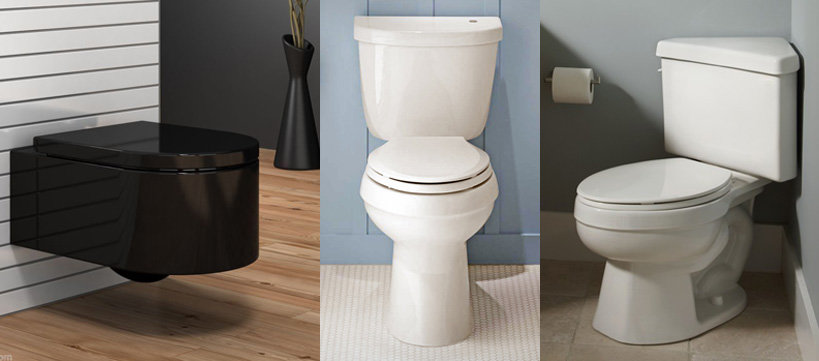
Learn How to Buy a Toilet in 5 Minutes – First Time Buyer’s Guide
‘How To’ articles on how to choose the right toilet for your home are all over the web. The reason you are here is apparent. You are not too familiar with what toilet types are there in the market place.
So you want to know what is the best toilet to buy within your budget. You could be on a remodel or building a new bath or powder room, or only looking for a replacement.
In a nutshell, you just want a toilet that gives you the least problem. You want it to be efficient, easy to clean and maintain, affordable, and blends well with your bathroom decor. And, of course, comfortable to use.
Fair enough, considering there are endless toilet models out there, to look for the right one that meets your requirements requires some research. That is what this article is going to do in crystallizing everything for your easy understanding.
So let’s spare you another one of those ‘How To Buy A Toilet’ articles that only scratches the surface, which leaves you with more questions than answers.
Here we go.
First Thing First – Determining the Toilet Minimum Space
This minimum space requirement is the most crucial first step you shouldn’t skip when you are remodeling or building a new bathroom. But if you are only replacing your existing toilet, you may want to jump to the next section.
Knowing the area size you have for a toilet will save you time and money from hunting down the wrong size toilet. So first thing first, get the right area space in your plan.
Having the right space is important so that you can use the facility in comfort. Also, maintenance work can be carried out safely with better access.
Imagine when you have to check on the tank that is leaking or replacing something as simple as the water supply line, you will need the space to handle those situations. A cramped space can render those simple tasks difficult.
And, you could be running in with the law as there are State regulations to what is the minimum space required for a toilet.
So how do you work out the minimum space for your toilet, and what is a good size toilet to fit in?
Clearance Space Is Gold
The space around your toilet must meet the minimum dimension as specified in the local building code for the bathroom.
Start with the distance from the back wall where your toilet sits against, to the front. And the gap between sidewalls and sanitary fixtures, observe the minimum distance.
Different states will have a different set of minimum clearance distance. So where ever you live, check the local building code for bathroom design and layout. Or an experienced local contractor should be able to advise you.
The side clearance is measured from the center of the toilet bowl to the sidewall or bathroom fixture (see Diagram 1.1 below). In most states, a clearance of at least 15 inches should be maintained on both sides of the toilet.
Of course, you can have more than 15 inches if there is ample room. A decent minimum side clearance starts at 18 inches. That will offer you a more comfortable space around the toilet.
So, try to allocate a wall to wall spacing (left to right) of 36 inches or wider. Otherwise, the minimum allowed by most state regulation is 30 inches wide.
The front space area, or the ‘Clear Zone’ should be at least 21 inches away from the front tip of the toilet bowl. A better and recommended clearance is 24 inches or more.
Also, take note to allow some space for door opening if your toilet is just next to the door. In which case, it will need to be wider or longer than 24 inches, or you will have to use an outward opening door.
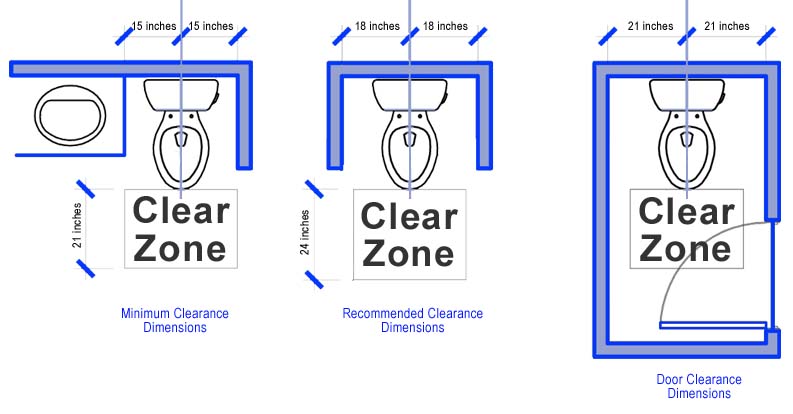
These are just some guidelines to help you plot out the best area for your toilet location. You may have a different layout that borders along or infringes the regulation. If that’s the case, discuss it with your contractor, who is in the best position to assist you.
Choosing the Right Toilet Size
Once you have gotten the space you need for your toilet, the next step you’ll learn is how to choose the right size toilet.
But first, you must know the rough-in size.
What is rough-in size?
The most important specification of a toilet is the rough-in size. Get it wrong, not only you can’t proceed with the installation, but it may also affect the choices of the toilet you can buy. But there is a way around it (more about the workaround in a while).
Rough-in size is the distance from the back wall to the center of the drain flange. That is the hole on the floor where the waste material gets drain away. (see diagram 1.2).
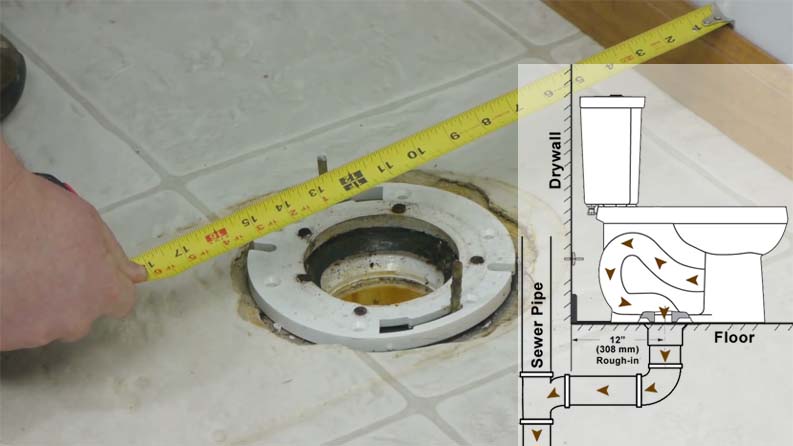
So the trapway outlet, which is the hole at the base of your toilet, must sit squarely on the drain flange. Otherwise, all hell will break loose with leaking at the bowl base every time you flush, or it will get clogged every other day.
A wax ring is used to seal the connection between the trapway outlet and drain flange.
The rough-in should be measured from the wall and not from any baseboard or molding. So make sure you measure from above the baseboard or molding to get an accurate measurement of the rough-in.
Get Your Rough-In Right
There are 3 rough-in sizes – 10 inches, 12 inches, and 14 inches. If you are replacing your toilet, you need to know the rough-in size to buy the right toilet that fits.
If you are planning for a new build or remodel, always go for the standard 12-inch rough-in. That’s the most common of the 3 rough-in sizes. You will find that you won’t be lack of choices when you are shopping for a toilet.
And finding a replacement is easy because all manufacturers will have the 12-inch rough-in for all its toilet models.
Can you use the common 12-inch toilet on a 10- or 14-inch rough-in?
Yes, you can still use a 12-inch by using an offset flange to adapt. Though compared to an exact match, this isn’t perfect, but it will still work like a charm. So don’t lose sleep just because you have a non-standard rough-in.
Measuring A Toilet
Now that you understand the minimum space requirement and the rough-in sizes, the final measurement you need is the physical size of the desired toilet.
The two dimensions you need to focus on is the toilet length (front to back dimension) and the bowl width. That’s what you need for the clear zone and side clearance.
The height usually doesn’t pose a problem for 99.99% of installations unless you are putting up at some odd places (God knows where that is). In which case, you still have other options, possibly like a tankless or wall hung toilet.
A standard size toilet will have its length starts at 28 inches to around 30 inches. If you have limited space for that dimension, then a compact size water closet is more suitable, which length is between 20 to 27 inches.
Regardless of toilet type, the bowl width is typically around 14 to 16 inches wide. So there’s not much play when you are dealing with the left-to-right spaces. And 14 inches for the bowl width is probably the minimum acceptable sitting comfort you can have for a toilet. Any narrower, it will be a toilet for kids.
Which Comes first? The Toilet Size or Minimum Space?
The better question to ask is, ‘How much space do you have for a toilet?’. That will eliminate the impulsive buying in you and be more practical in choosing the right size toilet.
Or at least, you will be looking for solutions if the space area is quite a challenge for a standard size toilet.
If you do not want any hiccups on your selection, it is always safer to know the minimum space you have before shopping for a toilet. From there, you can work out the maximum toilet dimension that will determine the range and type of toilets at your disposal.

So, these are the steps before you start looking for the ideal toilet for your prized bathroom.
- Know the minimum space area you have for the toilet
- Know the rough-in size
- Determine the maximum toilet size that will fit and meet the minimum space regulation
- Start shopping
Let The Shopping Begin
Now that you have all the measurement information in hand, the rest of ‘how to buy a toilet’ is just shopping fun. You will now be looking at the various toilet types, designs, and flushing capacity.
You are only limited by how much your dollar could stretch. Or perhaps, by the size of your bathroom. Also, there are tons of toilet reviews on this site to help you understand and pick the right toilet for your bathroom.
Which Flush Toilet Can Really Flush?
You might be tempted to start looking for a toilet that looks nice on the exterior to go with your new bathroom decor. Nothing is wrong with that, especially when you have spent a chunk on your bathroom design; you are not likely to compromise on aesthetic. So that might weight over features a little.
Whatever your case may be, you must not compromise on the flushing power and efficiency of any toilet you are buying. And knowing the type of flushing systems will help you avoid choosing the wrong potty. So let’s talk about the most talk-about function of the toilet – The Flush.
Gravity Flushing Toilets
Be it a single or dual flush toilet; there are two flushing systems the world is using – The Siphonic Flush and the Washdown Flush toilet.
But let’s not get into the details of the two flushing system here. If you are interested to know more, here’s the article Siphonic vs Washdown Toilet. Which Is Better?
You can tell the two flushing toilets apart quickly from their exterior. The siphonic toilet will usually have a visible S-shape trapway and generally has a more extended base. In contrast, the washdown will have a shorter base with no trapway or nothing that resembles the S-shape porcelain tube.
That’s easy to tell if the toilet is of the exposed trapway type. What if the toilet is skirted or having the trapway concealed? The next clue is the water spot in the bowl. The siphonic toilet will always spot a larger water surface than the washdown crapper. Typically about 8″ x 7″ to as big as 10″ x 12″.
The washdown toilet can never have a water surface area larger than (typically) 4″ x 5″, because it depends 100% on ‘push’ power to remove waste. The water volume in the bowl needs to be light to get push over the weir easily. And without the long trapway, it can’t produce a siphon, which is the biggest giveaway.
Washdown crapper has a loud waterfall style of flushing. It uses the sheer volume and weight of water to push out waste. Whereas the siphon pulls or sucks waste out in a much quieter manner.
However, the main advantage of washdown toilets is, they will never clog. It is impossible to plug a short and wide ‘trapway’ under regular use, unlike the siphonic crappers.
Most, if not all, toilets in American homes are of the siphonic type. Unless you grow up with a washdown closet, like the Europeans, it is not advisable to go for one. Apart from the loud flushing and small water spot, you might encounter difficulty in getting replacement parts or even support.
Also, the washdown toilets sold in the United States may have been adapted to meet the plumbing regulations or systems. So performance-wise may not be at the same level as the original design.
Pressure-assist Flushing

The pressure-assist flushing system is a tank-within-tank design. It uses water displacement to create air pressure within the tank to thrusts water out forcefully into the bowl. As a result, a siphon is produced much faster than the regular siphonic toilet.
The flushing is very much like an airplane toilet. You get that swoosh when the siphon is activated. Powerful and loud. You can forget about privacy as everyone at the dining table will hear you flush.
The good is it has a bigger trapway than the regular siphonic toilet. That means it can convey heavier loads than the regular siphonic closet. And with the powerful pressure thrust, chances of clogging up the trapway is pretty remote.
Not a bad idea if all you care about is to be clog-free and power flush. But you got to make sure the water pressure in your home is at least 25 psi (pounds per square inch). Otherwise, this power flush toilet will not work properly.
The advantages of this pressure-assist toilet are;
- It has a higher water level in the bowl, which keeps the waste submerge in water all the time.
- The flush is powerful and efficient.
- The sealed tank design eliminates sweating or condensation during humid weather.
The bad is, of course, the loud flushing noise it makes. And replacement parts aren’t that easily available compared to the regular flush toilets. So, you may want to keep some spare parts ready when the toilet acts up.
Single or Dual Flush?

Whether it is a siphonic or washdown system, you have a choice of a single or dual flush. So which is more desirable?
The dual flush will save you more water because it has a separate flush button to initiate a lower flush volume. Typically, it is set at 0.8 to 1.0 GPF.
The idea is a light or partial flush for clearing liquid waste. So you don’t need to initiate a full flush of 1.6 or 1.28 GPF, and water is saved.
In that case, does it mean the single flush is not a water-saving toilet?
Not entirely true. The dual flush just makes it more convenient and consistent to pull a light flush. You can still do a partial flush with the single trip handle by pulling half or three-quarter way. The tank will dispense a lower volume of water into the bowl.
The problem with the single flush is, you always tend to go for a full flush unless you remember to hold back half way of the turn. So you have to be mindful to control the actuation when you are only taking a leak.
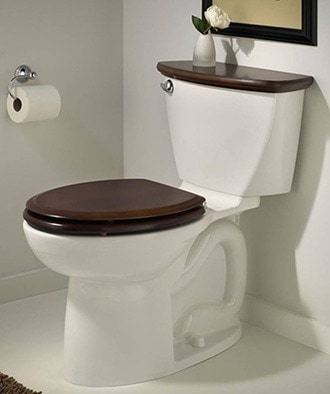
The push-button dual flush, which is normally fixed on the center of the tank cover, provides easy access. So where ever you stand around the toilet, the flush buttons are centralized to reach.
But that does not mean all dual flush toilets are push-button actuated. There are trip handle types as well. So you get to enjoy the extra shelf space in your tiny bathroom and the convenience of dual flushing. An example is this KOHLER Highline dual-flush model or the TOTO Connelly HET toilet.
Water Saving Toilets
Due to a law enacted in 1994, all residential toilets sold in the United States must comply with The Energy Policy Act of 1992. The law mandates that all home toilets can only use up to 1.6 gallons of water per flush. Compare to the period before where toilets are flushing away 3.5 gallons of precious clean water.
Then in 2004, EPA conceived the WaterSense Program. Two years later, it released its specification for tank-type HET (High Efficient Toilet), which is capped at 1.28 gallons per flush (GPF). The intention is to encourage toilet manufacturers to redesign toilets for higher flushing efficiency using lesser water.
If saving water is one of your priorities, then look out for toilets with the WaterSense sticker. These are High-Efficiency Toilets (HET) that use less than 1.6 gpf of water without compromising on performance. Otherwise, with the 1.6gpf cap, you are still doing a little part for water conservation.

The WaterSense label is proof that a toilet has gone through a certification process. It has to meet all the stringent criteria for both efficiency and performance.
And to earn that recognition, it has to be certified by an independent test lab recognized by EPA.
Here are some of the best toilets to buy that carry the WaterSense label.
Mesmerizing Toilet Bowl Shapes
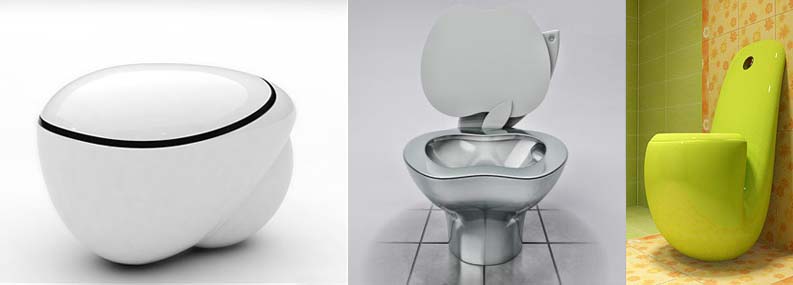
Over 90% of toilet bowls come in 2 shapes – elongated (or oval) and round. Yes, that’s rather boring if you asked and sorry to disappoint.
You may have seen a rectangular or odd-shaped bowl, and think they are cool. They are, but looking for a replacement seat can be a nightmare. You probably have to wait longer to get one, because very few makers would stock something that sells only once in a blue moon.
And these unconventional style seats are not cheap. Be prepared to pay over $100 for a third party toilet seat that’s only as close as it can get. The original seat can cost as high as over $300 a pop. Of course, if you have a deeper pocket, nothing is in your way of getting what you want.
Round bowls usually cost less and take up less space. They are generally shorter than the elongated bowl by about 2 inches. Unless you have a space constraint, always go for the elongated bowl. Most guys will hate to have their proprietary body part resting on the bowl rim, especially with a round pan.
![]() Think of the power button icon; it makes you wonder if this was coined by a guy while pooping on his round bowl toilet.
Think of the power button icon; it makes you wonder if this was coined by a guy while pooping on his round bowl toilet.
An elongated bowl provides better support and comfort. And since it is most people’s favorite, it will be easier to find a replacement seat. And they don’t cost you limbs even to get one from the original toilet manufacturer.
One-piece or Two-Piece Toilet?

Your next consideration is whether it should be a one-piece or two-piece toilet. That’ll depend on your preference for aesthetics and ease of maintenance. Performance-wise, they are similar, and they can be using similar flushing mechanism as well.
For a more detail comparison, you may want to read up this article – One Piece vs Two Piece Toilet. Which Is Better?
And here’s a quick comparison of the two toilet types.
| One Piece Toilet | Two Piece Toilet | |
|---|---|---|
| Appearance | Sexy | Can be sexy but usually not |
| Easy to clean | Since there is no joint between the bowl and tank, chances of dirt and bacteria accumulating are eliminated. | Grime, mold and bacteria can build up at the joint between the tank and bowl, difficult to clean thoroughly without removing the tank. |
| Tank Leakage | Only possibility is water from the tank leaking into the bowl. | Water not only leaks into the bowl, it can leak out if the tank-bowl coupling is not properly made or due to age. |
| Ease of Installation | Cumbersome and heavy. But once secured to position, it’s 95% done because you don’t have to deal with the tank installation. | Bowl and tank are installed separately, and each portions are easier to manage even for one person. |
| Replacement | If the tank or bowl is broken, you have to replace the entire toilet. | Tank and bowl can be replaced separately. |
| Cost | Generally higher than the two-piece toilets. | Usually perceived as low cost. |
| Performance | Both 1-piece and 2-piece toilets are comparable in terms of service life and functionality | |
Toilets with Concealed & Skirted Trapways

The modern toilet is more than a functional device to help dispose of your waste; it is also designed to look good in the bath or powder room.
Skirted design or concealed trapway toilets look way cooler than those exposed types. Those exposed trapways are like the ugly varicose veins, and it’s hard to clean.
If you plan to remodel your bathroom for a more modern look, choose the skirted design.
The straight sides of the skirting make it hard to trap dirt and easier to keep clean. But they are more costly than traditional models. Probably because of the extra ceramics needed to hide the trapway. And they are more complex to manufacture.
But rest assured, the cost difference won’t hurt your wallet much. The eye-pleasing exterior and the ease of upkeeping will more than make up for the higher cost.
Want an even better-looking toilet? Pay a little more and get a one-piece and skirted toilet for your prize bathroom. That’s the best of both worlds, and you will have even more time to watch your favorite cat videos.
Wall Hung Or Wall Mounted Toilet

Wall hung, or wall-mounted toilets are great space saver if you have a small bathroom. You can easily save about 9 inches of floor space, front to back. And they look way cooler than those floor-mounted toilets.
The tank is hidden in the wall, which is supported by an in-wall carrier. So on the outside, you can only see the flush plate or flush button and the bowl. Access to the tank is through the flush plate opening so that parts replacement or maintenance can be carried out easily.
The biggest takeaway of wall hung toilets is they are super easy to keep clean. Most people choose the wall hung toilet mainly for this reason. And they are comparable to the regular floor sitting models in terms of performance.
The best time to install a wall hung toilet is during remodeling or constructing a new bathroom. So make sure to include it in your plans when you decide to revamp your bathroom to a more modern look.
If you are replacing your floor sitting model with a wall-mounted toilet, the work is going to be massive. You will need to re-plumb the drain pipe from the floor to the wall. And there will be hacking, plastering, and tiling work need to carry out. It won’t be done in a day, that’s for sure.
The bowl and in-wall carrier system usually come as a package, or you can opt to purchase them separately. The overall cost to replace your existing floor toilet to a wall-hung is about $2000 to $3000. The bulk of the cost goes to labor and building material.
The Main Concern About Wall Hung Toilets

One important factor to consider is the weight limitation of wall hung toilets. If you have a family of heavy weights, you are better off with a floor mounted toilet.
A good carrier system that supports the tank and bowl should be able to withstand a maximum weight of up to 880lbs or 400kg. And they can last as long as the floor-mounted models if you don’t abuse it.
If you are still concerned about its reliability, please know that over 90% of toilets in Switzerland are wall hung. The key is to get a proven carrier system like the Geberit from Switzerland. And once you tried it, you won’t want to go back to a floor-mount crapper ever again.
Here’s a TOTO wall hung toilet review which features the Geberit in-wall carrier system.
Despite the weight limitation, more and more homes are getting on with wall-hung toilets. Besides saving you some precious bathroom real estate, you will love the clean line appearance and barrier-free access. And no more dragging yourself when it comes to toilet cleaning. It’s a breeze now.
Touchless Flushing Toilet
The toilet is the dirtiest place in any homes or commercial properties. If not well taken care of, it can quickly become a breeding ground for harmful bacteria and germs.
And our hands are frequently in contact with many household items, including cutleries. Unknowingly, food may get contaminated, and you will suffer the brunt of eating dirty stuff.
Washing your hands is not 100% fail-safe, either. Most people don’t wash their hands thoroughly after using the toilet. More so when they did it in haste, maybe to answer the door or a phone call.

Touchless toilets can help eliminate the possibility of spreading diseases by contact.
Raise the level of hygiene in your home with a touchless flushing toilet. It won’t cost you much compared to a normal trip-lever or push-button flushing system.
In fact, you can even retrofit your existing toilet to a touch-less one with a touchless toilet flush kit. And you don’t need to call a plumber as the installation is pretty intuitive.
With the touchless flushing, there won’t be any compromise on the flushing performance. The toilet will still flush normally, except the actuation is now control by a small motor that is mechanically connected to the flush valve.
Common household batteries power the motor operation. So a utility power failure will not affect flushing. The disadvantage is, you need to replace the batteries periodically. So have some spare batteries ready and keep them within reach.
Here’s a popular touchless flush kit from KOHLER.
Even better, make the seat touchless as well with a bidet seat. But it has to be a TOTO Washlet with the auto open and close seat. The S350e and S550e are the only models that have the automatic seat and cover.
Warning: The popular TOTO Washlet S350e Toilet Seat may cost more than the toilet itself but you will love it.
Or if you have a generous budget to replace your existing tank and bowl closet, you may want to consider an intelligent toilet. The hygiene level is unprecedented with a smart toilet like the TOTO Neorest.
Comfort Height Toilet

Comfort height toilets are tall bowl toilets. They are usually about 2 to 3 inches higher in sitting height than regular water closets.
The seat height of a comfort height toilet is usually 17 to 19 inches high measured from the floor to the top of the seat. But you will find most of the comfort height toilets are 17 inches or slightly higher.
The bowl height of a regular toilet measures about 15 inches from the floor to the top of the bowl rim. Whereas most comfort height toilets begin at 16″. The toilet seat will add another 1 to 2 inches to about 17 to 18 inches high.
But it is rare to find a toilet with a seat height of 18 inches and above. This article explains why – Lies And Truth About Comfort Height Toilets
Different manufacturers will have a different name for ‘comfort height’.
American Standard calls it the Right Height, and TOTO terms it as Universal Height. They all mean the same chair height or comfort height toilets.
But not everyone appreciates such ‘comfort’, especially if they are physically short. Or the lack of knee-height that they have to tiptoe, or their feet are barely touching the floor when seated. One way around this situation is to use a step stool which is also great for better evacuation.
And comfort height is not purely to provide comfort. Do spare a thought for your elderly family members or someone who may have leg injuries or bad knees. They will appreciate the extra height that helps alleviate the pain when using the facility.
The majority of users love these comfort height toilets. Simply because of the ease of sitting down and getting up. You will grow to love these comfort height toilets as you age.
ADA Compliant Toilets
ADA stands for the American with Disabilities Act. The act is drawn in 1990 to protect the rights of people with disabilities to access public facilities and services freely and independently.
For a toilet to be ADA compliant, the primary consideration is the sitting height requirement, which should allow for maximum accessibility for people in wheelchairs or other disabilities. The seat must be at least 17-inch from the floor to the toilet seat top, and up to a maximum of 19-inch.
Sounds familiar?
An ADA toilet is also a comfort height toilet. But a comfort height toilet is not necessarily an ADA compliant toilet.
Comfort height toilets do not need to comply with other provisions of the act. For example, another requirement of the bill states that the actuation force on the trip handle or push button must be light enough for the disabled to function and access easily.
But the toilet itself can’t do much to alleviate the inconvenience for the less fortunate. Whether it is comfort height or ADA compliant, you should also look into other requirements. Such as providing more clearance space around the toilet, install grab bars, and slip-proof flooring if necessary.
Especially for elderly folks, ample support is a must for convenience and safety.
Here’s ADA Standards for Accessible Design if you are interested to know more.
The cost difference between a standard and comfort height or ADA compliant toilets is no bother at all. If you need a tall toilet, go with the ADA model. You can’t go wrong with it.
Who Should Install Your Toilet?
Probably by now, you may have decided on what toilet to buy. It’s time to think of how you are going to install it.
Installing a toilet can be fun for some people. It is not complicated, but if you have not done one before, it can pose quite a challenge. So start with watching a Youtube video on toilet installation. You will surely pick up some tips and avoid having an improper installation.
Otherwise, be like what the majority of people will do, hire a plumber.
Communication Is Key To A Successful Toilet Installation
If you are going to hire professional help, it helps to communicate with your plumber on the toilet type and model. So that he knows what to expect and prepare the necessary materials before arriving at your home. Then the work process can be a lot smoother, and nobody gets frustrated.
Even better, read up the installation manual to understand the work sequence and materials required for the work. Some toilets may require special attention to the installation sequence.
Especially for some skirted models, the toilet seat has to be installed first before securing the toilet to the flange. So imagine the trouble you can avoid if you have brought this to your plumber’s attention before the installation begins.
You may have read in forums or blogs about some bad experiences with plumbers. And the less-than-acceptable work produced. Usually, it is due to poor communication between the users and their plumbers.
Or that they leave the plumbers to figure their way around with the installation. This often leads to some improvise work that doesn’t follow the manufacturer’s installation protocol. When problems arise, the warranty can be a nasty issue to deal with later.
And please make sure you have the toilet in hand and check it thoroughly for defects and quality issues before you fix an appointment with your plumber. You may be asked to compensate for the time and travel when the guy arrives, and you don’t have the toilet ready.
A well prepared installation is key to a full functioning and trouble free toilet. Remember that.

Summary
Buying a toilet can be fun and getting the right one is all that matters.
You begin by knowing the space area that you have. Then get the right rough-in size, follow by where and how to install the toilet according to your plan. After which you are on your way to shop for the best toilet that suits your needs and budget.
You have learned the two types of flushing systems, that is the siphonic and washdown system. And also, the super-efficient power-assist flush toilet, which is good if you are not bothered by the louder flush it makes.
And if the running cost is a concern, there are the water-saving toilets to save you water and money. Look out for the WaterSense label, which indicates the toilet is using a maximum of 1.28 GPF. That’s 20% less on water consumption compared to the 1.6 GPF models.
If you are a single lady who lives alone, it doesn’t matter whether you should get a round or elongated bowl. For guys, the elongated bowl is more welcoming definitely. But of course, if space is a problem, then a round bowl can get you a little more legroom. And always go for the 12 inches rough-in if condition allows.
And talking about space constraints, there are space-saving toilets to meet your needs. Or there is always the wall-hung models to save your day.
The smallest known model is just 23 inches long. You can get the full scoop of small toilets in this Best Of 24-Inch Shortest Toilets (Small Toilets Round-Up).
The rest of the considerations will depend on your preferences. Whether it is easy maintenance, hygiene, eye-pleasing, or convenience, there is no lack of choices. From the simple two-piece with exposed or concealed trapway to the ultimate models of the intelligent toilet range, you only have your budget to blame.





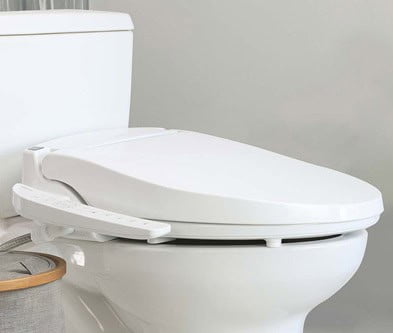

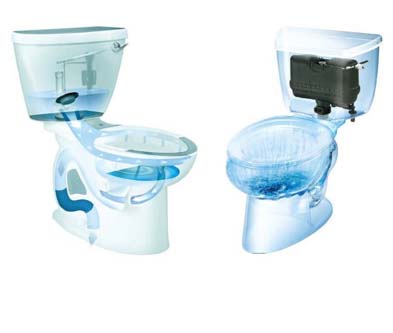

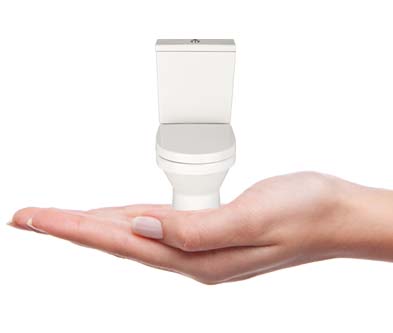
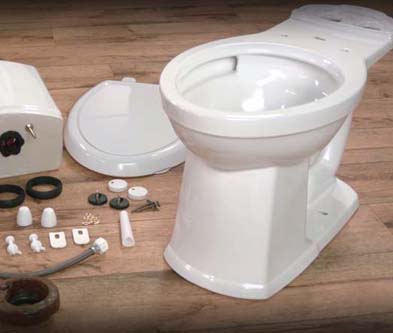
My toilet was recently cracked after my son dropped something really heavy on it. We need to find something new but I have never purchased a toilet before. I really like that you talked about getting one that fits in the space you already have so you don’t run into problems.
Hi Trevor. Thanks for your comment and apologies for this late reply. If you need help getting the replacement toilet, feel free to contact me.
Martin
I just bought an American Standard Reliant, and I’m highly disappointed with the amount of water surface area – I don’t like cleaning every time after a #2. I can’t seem to find good info on the internet about sufficient weir levels that keep me from scrubbing each time. Do you have a suggestion for under $200? Round toilet, 16″ h, 12″ rough-in.
Hi Dave.
You want to try TOTO Entrada Model:CST243EF?
Water surface size is slightly bigger at 8-3/8″ x 10-1/2″, versus American Standard’s 9″ x 8″. Round bowl, 12″ rough-in, and 16-1/8″ bowl height. And yes it is under $200 on Amazon.
Amazon link: https://www.amazon.com/CST243EF-01-Entrada-1-28GPF-CalGreen-Two-Piece/dp/B00J4LFDIA
Technical Specification – https://www.totousa.com/filemanager_uploads/product_assets/SS-00635_CST243EF.pdf
MaP Rating: 1000 (AS Reliant is 600)
And you may want to read this article about Water Surface Area – https://toiletfound.com/water-surface-area/
Let me know if you need further help.
Very informative and helpful. Thank you.
Just a quick question: Can a syphon replace the plugged wash down flush unit in my tank? The pedestal toilet definately dosen’t have that “u” or “s” bend though. Just considering a cheap way to boost the flush power only for solid waste. My landlord won’t let me replace the toilet and I thought this might clear heavy loads in one flush and save water. But, I don’t want to contravene any laws or regulations. Is this allowed? Or will it not work because the pan doesn’t have the “s” bend? Its a low level, not close coupled, so it has a short flush pipe. Am also considering getting an old vintage high level tank, (if possible) if that won’t work. The extra gravity might make a difference. But not sure if a refit of these vintage tanks is allowed. Or perhaps I don’t as a diyer have to stick to all the same regulations a plumber or builder would, not sure. Any guidance and/or suggestions appreciated.
Hi Simon.
The regulation only states that the flush volume should not exceed 1.6 GPF. And in States like California, the maximum allowable flush volume is 1.28 GPF. Other than that the usual plumbing code applies to the draining and piping system which you have no authority over. So you’ve got to leave them as it is.
Now, if you want to modify the tank to give it a more powerful flush, the things you need to deal with is how you can fit the new tank to the existing bowl. This will be a challenge that I have no clear answers for you. It depends on your creativity. You will have to find hardware or invent some to adapt. The high level tank is a good idea which I think you can do with the right piping size and gasket/seal to make sure no leaks. Also you may need to adapt the water supply too. I see lots of trial and error to be expected here. Will you try? I’ll be keen to know how and what you’ve done. 🙂
Martin
very informative. I learnt a lot.
Cheers.
@Thommo Thanks 🙂